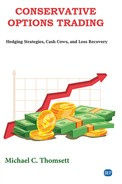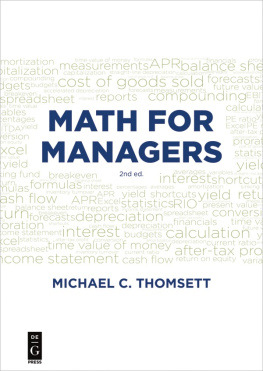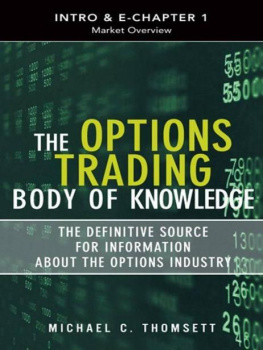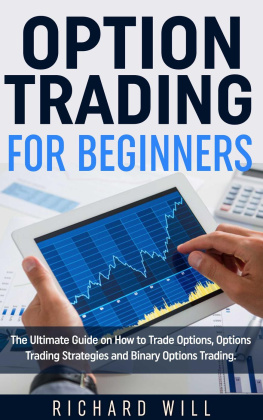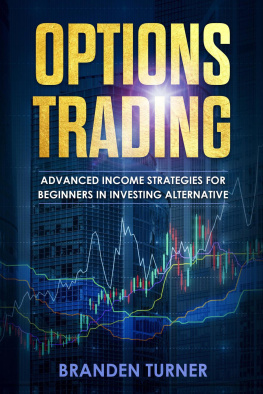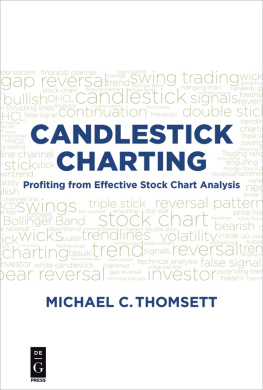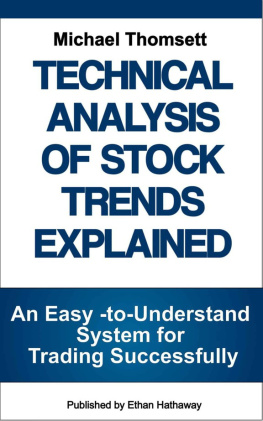Michael C. Thomsett - Conservative Options Trading: Hedging Strategies, Cash Cows, and Loss Recovery
Here you can read online Michael C. Thomsett - Conservative Options Trading: Hedging Strategies, Cash Cows, and Loss Recovery full text of the book (entire story) in english for free. Download pdf and epub, get meaning, cover and reviews about this ebook. year: 2019, publisher: Business Expert Press, genre: Business. Description of the work, (preface) as well as reviews are available. Best literature library LitArk.com created for fans of good reading and offers a wide selection of genres:
Romance novel
Science fiction
Adventure
Detective
Science
History
Home and family
Prose
Art
Politics
Computer
Non-fiction
Religion
Business
Children
Humor
Choose a favorite category and find really read worthwhile books. Enjoy immersion in the world of imagination, feel the emotions of the characters or learn something new for yourself, make an fascinating discovery.
- Book:Conservative Options Trading: Hedging Strategies, Cash Cows, and Loss Recovery
- Author:
- Publisher:Business Expert Press
- Genre:
- Year:2019
- Rating:5 / 5
- Favourites:Add to favourites
- Your mark:
- 100
- 1
- 2
- 3
- 4
- 5
Conservative Options Trading: Hedging Strategies, Cash Cows, and Loss Recovery: summary, description and annotation
We offer to read an annotation, description, summary or preface (depends on what the author of the book "Conservative Options Trading: Hedging Strategies, Cash Cows, and Loss Recovery" wrote himself). If you haven't found the necessary information about the book — write in the comments, we will try to find it.
Conservative Options Trading: Hedging Strategies, Cash Cows, and Loss Recovery — read online for free the complete book (whole text) full work
Below is the text of the book, divided by pages. System saving the place of the last page read, allows you to conveniently read the book "Conservative Options Trading: Hedging Strategies, Cash Cows, and Loss Recovery" online for free, without having to search again every time where you left off. Put a bookmark, and you can go to the page where you finished reading at any time.
Font size:
Interval:
Bookmark:
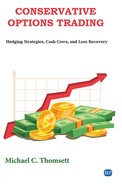

Conservative Options Trading
Conservative Options Trading
Hedging Strategies, Cash Cows, and Loss Recovery
Michael C. Thomsett
.jpg)
Conservative Options Trading: Hedging Strategies, Cash Cows, andLoss Recovery
Copyright Business Expert Press, LLC, 2020.
Cover image licensed by Ingram Image, StockPhotoSecrets.com
All rights reserved. No part of this publication may be reproduced,stored in a retrieval system, or transmitted in any form or by anymeanselectronic, mechanical, photocopy, recording, or any otherexcept for brief quotations, not to exceed 400 words, without the priorpermission of the publisher.
First published in 2020 by
Business Expert Press, LLC
222 East 46th Street, New York, NY 10017
www.businessexpertpress.com
ISBN-13: 978-1-95152-712-9 (paperback)
ISBN-13: 978-1-95152-713-6 (e-book)
Business Expert Press Finance and Financial Management Collection
Collection ISSN: 2331-0049 (print)
Collection ISSN: 2331-0057 (electronic)
Cover and interior design by Exeter Premedia Services Private Ltd.,Chennai, India
First edition: 2020
10 9 8 7 6 5 4 3 2 1
Printed in the United States of America.
Abstract
The world of options is considered high risk by many. At its original options trading in the modern era began in the early 1970s when the first listed calls were offered on a short list of companies; a few years later, put trading was added.
Since this time, options trading has become available on most companies on the large public exchanges. However, the high-risk reputation of options has persisted through the years, even as dozens of new and often conservative strategies have been introduced. Today, the best use of options is not to speculate on price movement, but to hedge market risk in equity portfolios. Many strategies can combine hedging with income, establishing advantageous circumstances for risk-averse traders. It is possible to apply several strategies to reduce risk and, in some instances, to eliminate market risk completely.
This book examines the many ways this can be accomplished, based on options for three highly rated companies. These are qualified as a first step by exceptionally attractive fundamental attributes and trends: Higher than average dividend yield with dividend increases over at least 10 years; a range of moderate price/earnings ratios each year; growing revenue, earnings, and net return; and level or declining long-term debt as a percentage of total capitalization.
Keywords
Bollinger bands; chart analysis; conservative; portfolio; volatility; downside risk; exercise; extrinsic value; intrinsic value; time value; implied volatility; spread; straddle; insurance put; covered call; LEAPS options; leverage; momentum; contingent purchase; contingent sale; speculation; strike price; expiration; underlying security; tax rules; rescue strategies; risk; long; short
Contents
The Elusive Goal: Low Risk and High Yield
The elusive goal for every trader is to achieve the combination of low risk and high yield. Is this ever possible?
The market invariably brings you both good news and bad news. The bad news: Markets are volatile and risky, and any capital placed at risk could result in losses, at times catastrophic losses. The good news: These market risks can be hedged effectively using conservative options strategies.
Coupling the words conservative and options may seem surprising, since the long-standing reputation of the options market has been exotic, high risk, and inappropriate for many if not most investors, both institutional and retail.
This does not have to be the case.
The options market is becoming increasingly recognized as much more than a form of pure speculation. Today, growing numbers of investors are recognizing that options are most effective as tools for managing a portfolio, reducing and eliminating its risks through hedging strategies, and improving profits.
This book demonstrates how a conservative portfolio can be made safer and more secure, while increasing income. This is accomplished through the combination of equity positions with specific and conservative options strategies. The intention is not merely to augment net profits but to protect the profitability of the equity side of the portfolio as well. This idea is dramatic in the positive effect it has on an institutional portfolio.
The problem every investor and trader faces is twofold: First and foremost, investment decisions must be conservative enough to protect against losses. It means that many opportunities must be passed up because the risks are perceived as too great. Second, the goal must be to match and beat inflation and taxes, the double impact that demands seeking higher returns.
How can you seek higher returns in this portfolio, while continuing to observe the essential demand for conservative strategic management?
Many market insiders and experts are pessimists on this question. They point out that your chance is only through broad diversification of risk, and complex asset allocation as management tools. Both ideas present profound problems for every portfolio. Broad diversification means trying to attain the vanilla medium return of the market. A majority of mutual funds, for example, are broadly diversified but they underperform the market average. In fact, according to one source, the average actively managed stock mutual fund returns much less than the overall market. In 2017, the returns for the three major indices and for mutual funds were:
Dow Jones Industrial Average | 25.08% |
S&P 500 | 21.83% |
NASDAQ | 29.64% |
U.S. mutual funds | 18.26% |
It was not just a one-year dismal report. Making matters worse, even beyond the average outcome, most funds perform beneath the average of the broader market. One study concluded that over 15 years, an average of more than 90 percent of funds reported yields lower than the overall market:
% yielding less | |
than market average | |
All mutual funds | 83.74% |
Large cap | 92.33% |
Mid cap | 94.81% |
Small cap | 95.73% |
Average | 91.65% |
Why is this so? The answer is at the crux of the message in this book. Any observer of the mutual fund performance phenomenon would wonder why the average mutual fund underperforms market averages and why most funds perform under market averages.
The three disadvantages mutual funds have over other institutions (e.g., insurance companies, banks, pension plans, and specialized advisory service provides) include overdiversification, fees, and requirements for cash on hand. Mutual fundsnotably very large onesmay simply hold positions in too many segments of the market, so that their returns are going to be average at best. Returns are further diminished by fees that mutual funds charge (1.44 percent on average). Finally, funds hold between 3 and 7 percent in cash to meet obligations, and this dead money does not earn.
Font size:
Interval:
Bookmark:
Similar books «Conservative Options Trading: Hedging Strategies, Cash Cows, and Loss Recovery»
Look at similar books to Conservative Options Trading: Hedging Strategies, Cash Cows, and Loss Recovery. We have selected literature similar in name and meaning in the hope of providing readers with more options to find new, interesting, not yet read works.
Discussion, reviews of the book Conservative Options Trading: Hedging Strategies, Cash Cows, and Loss Recovery and just readers' own opinions. Leave your comments, write what you think about the work, its meaning or the main characters. Specify what exactly you liked and what you didn't like, and why you think so.

